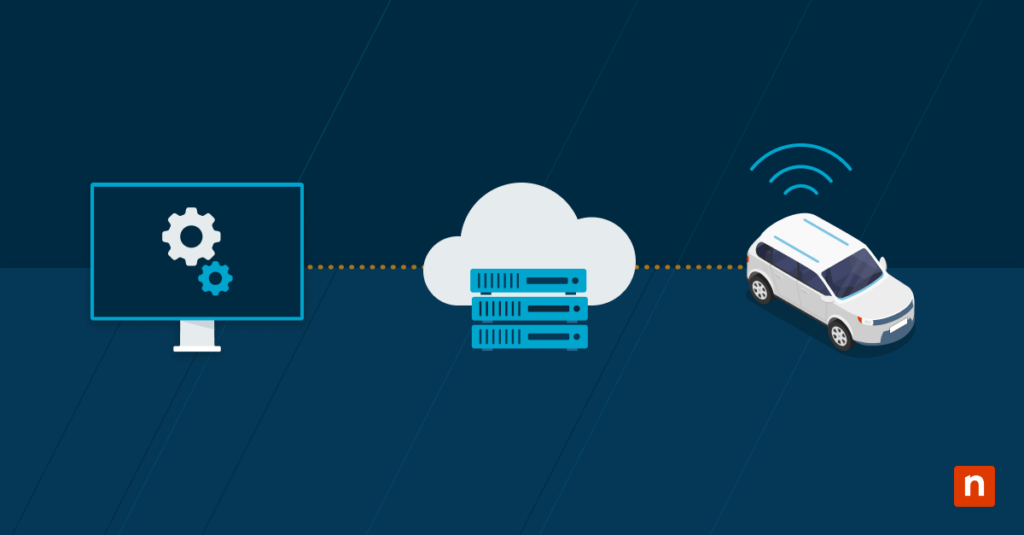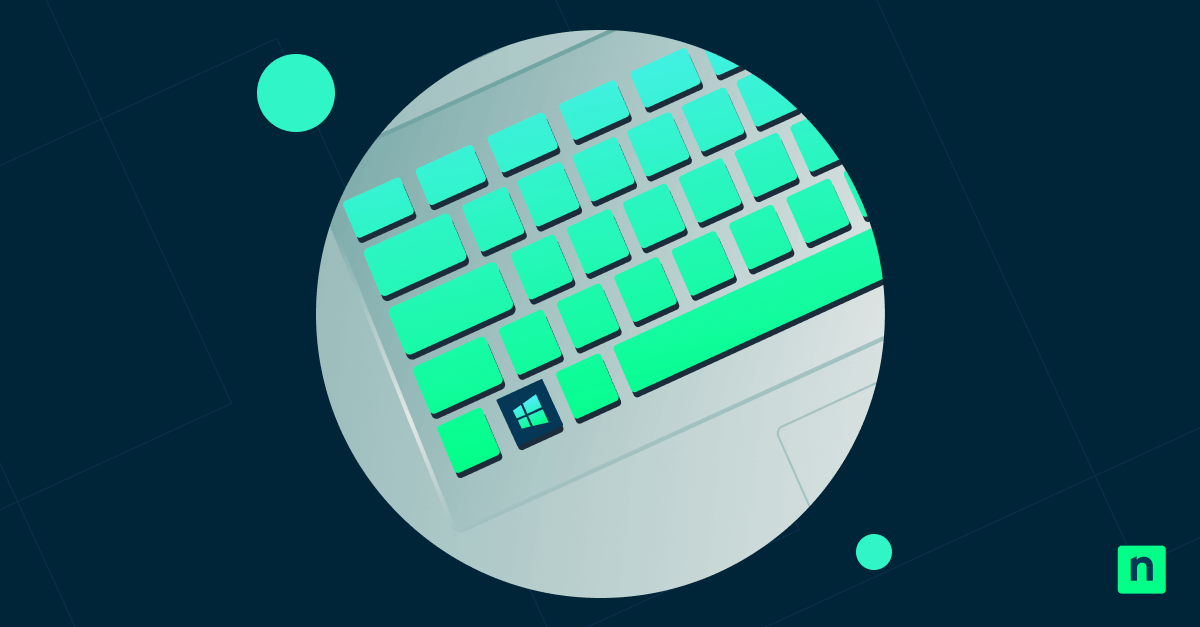Key points
- What OTA updates are: Over-the-air (OTA) updates are wireless software updates delivered directly to devices like smartphones, tablets, IoT, and vehicles without requiring a physical connection.
- Types of OTA updates explained: OTA updates can be categorized by purpose (FOTA vs. SOTA), delivery method (full vs. incremental), and installation method (A/B vs. traditional), each affecting performance, reliability, and security.
- Benefits of OTA updates: OTA updates enhance device security, deliver new features, and extend hardware lifespan by fixing vulnerabilities and improving performance, all without user intervention.
- Applications of OTA updates: OTA updates are used in different systems and industries such as consumer electronics, industrial machinery, vehicles, IoT, and satellites.
- Best practices for OTA management: Secure OTA deployments require update verification, rollback protection, staged rollouts, and proper scheduling, especially in enterprise IT environments.
Over-the-air (OTA) updates are software updates delivered to and installed on your devices, without you having to plug them in. This guide explains what OTA updates are, the OTA update process, how it works, and how they benefit you. It also describe the role and importance of OTA updates in IT.
Introduction to over-the-air updates
Over-the-air updates are delivered to your mobile phones, tablets, and other embedded devices via their wireless internet connection (hence them being delivered “over the air”). OTA software updates usually refer to a device’s operating system or core software. OTA updates can be configured to be automatically installed by the device’s operating system once downloaded for optimal security and convenience.
Before OTA updates, you had to manually plug your mobile devices into a computer to install updates, either downloaded from the manufacturer’s website or by using a specific update download utility for that device. This inconvenient process meant that users would neglect to install updates (or not be aware that updates were available).
Over-the-air updates mean that devices are more likely to be up to date with the latest software patches that improve performance and security, and include the latest operating system features from the manufacturer.
Take control of OTA updates across all your mobile and remote devices with a robust MDM solution.
→ Learn more about NinjaOne MDM
How the OTA update process works
From the end-user perspective, the OTA update process depends on whether they have enabled automatic or manual updates:
- Automatic updates are delivered without user interaction. It’s increasingly common for the automatic download and installation of critical security updates to be automatic by default.
- Larger operating system updates that may use up your mobile data allowance are usually performed manually. In this case, you’ll receive a notification that an update is ready to download. Once the update data has been downloaded, you’ll receive another notification stating that it’s ready to install. It’s also possible to set all updates manually, though this is not recommended.
OTA updates for mobile devices are provided by the manufacturer, and notifications about them will come from the device operating itself. Additionally, OTA updates have also become more modular in recent years. Take Android’s Project Mainline for example. The modular method directly updates specific system components through the Google Play infrastructure. Apple also does something similar by providing rapid security responses outside of major iOS or macOS versions. This approach has helped improve patching speed and reduced the need for complete system upgrades.
See OTA updates in motion—watch this brief video guide: ‘What Are Over‑The‑Air (OTA) Updates?‘.
Types of OTA updates
We can divide the types of Over-The-Air updates into three categories: by purpose, delivery method, and installation method.
By purpose
- FOTA (Firmware Over-The-Air): Firmware OTA updates focus on lower-level system components, which are important for maintaining hardware stability, connection, and security. Some examples of FOTA are BIOS, security patches, or new additional features on a mobile phone.
- SOTA (Software Over-The-Air): Software OTA updates, on the other hand, target system components such as the operating system for functionality enhancement, pushing additional features to applications, or any improvement-related updates concerning software.
By delivery method
- Incremental OTA Updates: Incremental updates deliver the differences (or “diffs”) between the current version and the target version of the software. This delivery method is utilized for minor version changes or minute scheduled patches.
- Full OTA Updates: A full OTA update delivery method deploys an entire system image to replace all files on the device’s system partition. This is commonly implemented for major system updates or when updates are too complex for incremental OTA update delivery.
By installation method
- A/B (seamless) updates: Devices using A/B partitioning have two system partitions—while one is active, the other is updated in the background. After a reboot, the device switches to the updated partition, enabling safe rollback if the update fails.
- Traditional (non-A/B) updates: In a traditional OTA setup, the update is written directly to the live system partition during installation. If the update is interrupted or fails, it can leave the device in an unusable state, which is why this method is less preferred for critical systems.
Applications of OTA updates
While OTA updates are usually discussed in the context of mobile phones and tablets, any embedded device that has upgradable software and a network connection can benefit from over-the-air software updates:
- Consumer electronics: The software that powers consumer electronics is becoming increasingly complex and connected. Even low-budget televisions now include full-blown operating systems and internet connectivity, which requires regular patching.
- Industrial machinery: Industrial machinery that uses remote control systems and microcontrollers can receive OTA updates to ensure its continued operation.
- Vehicles: Modern electric vehicles are basically giant batteries on wheels, with powerful embedded computers to provide driving assistance, entertainment, and navigation — all of which need regular OTA updates to remain useful.
- IoT: Internet of Things (IoT) devices, such as smart lighting and heating, as well as home automation devices, all benefit from OTA updates.
- Satellites and spacecraft: Once a satellite goes up, it doesn’t come down (at least in one piece), so updates to its embedded systems are sent wirelessly. The Voyager space probe and Mars rovers also get their updates OTA.
Benefits of OTA updates
The benefits you receive from enabling automatic OTA updates on your devices are:
- Enhanced security: Vulnerabilities to embedded devices like smartphones, tablets, smartwatches, and IoT devices are regularly discovered. These vulnerabilities are patched via OTA updates, leaving your device open to attack if not regularly updated.
- New features: New functionality is regularly included in operating system updates delivered over-the-air.
- Device longevity: It’s also possible for hardware flaws in mobile devices to be mitigated via OTA updates, increasing the lifespan of devices that have a known design flaw.
Best practices in using OTA updates
To ensure safe and effective delivery of over-the-air updates to devices, here are some best practices you can follow:
Verify update authenticity
All OTA update packages are authenticated through digital signatures. To prevent malicious updates from installing, ensure you’re receiving updates that are cryptographically signed and verified by the device before installation.
Implement rollback protection
Enforcing rollback protection can safeguard your devices from being downgraded to an older version. It works by blocking users from intentionally or manually installing previous firmware versions. This helps reduce the risk of exposing them to older and vulnerable firmware versions.
Practice staged rollouts
Minimize disruptive deployment risks by gradually releasing updates to small groups of users only. This way, it can help you catch bugs or performance issues before wide distribution.
Schedule updates during off-hours
Automate update installation during times when devices are commonly not in use, such as inactive hours. You can also allow users to schedule installation at their most convenient time to minimize productivity loss.
Support background downloads
In line with maximizing productivity, you can implement background downloads of OTA updates. This prevents updates and installations from interrupting the users when they are using the device.
Enforce update policies through MDM
In enterprise environments, use Mobile Device Management (MDM) solutions to automate update schedules, enforce security compliance, and prevent users from disabling critical updates.
Discourage indefinite update delays
Encourage users to download and install OTA updates immediately when they become available. This is essential, especially when critical updates are needed to reduce device vulnerability. Additionally, outdated systems are highly vulnerable to exploits and may eventually become unsupported. That’s unless the expected updates are not postponed.
Discover how NinjaOne can give you real-time visibility and control over every device’s updates.
Start a free trial or watch a demo of NinjaOne MDM
What is the risk of not using OTA updates?
Software updates are only effective if you actually install them, so don’t ignore the notifications you receive, and make sure you install updates when they become available.
Similarly, if you disable automatic over-the-air updates and fail to regularly check for manual updates, you are putting yourself at risk. The inconvenience of being briefly interrupted by an automatic update is far less detrimental to you than the potential damage caused by malicious code or an unpatched device flaw.
While some OTA updates will change the functionality or terms of use for your device and software, being up-to-date has more long-term advantages for your security and privacy. There is also a small risk of an over-the-air update being used to deliver malware if the device manufacturer is compromised. However, the chances of this are incredibly small compared to the probability of an infection or hack of an unpatched mobile device.
The importance of OTA updates in enterprise IT
OTA updates are vital in enterprise IT environments. Without them, IT departments would need to regularly recall all staff devices for manual updates, an almost impossible task at scale.
However, the downside of relying on automatic over-the-air updates to help keep your IT infrastructure secure is that your employees may have disabled them. The Mobile Device Management (MDM) solution provided by NinjaOne gives you full visibility and control over your organization’s mobile devices, so that you can enforce update policies and make sure devices are patched.








